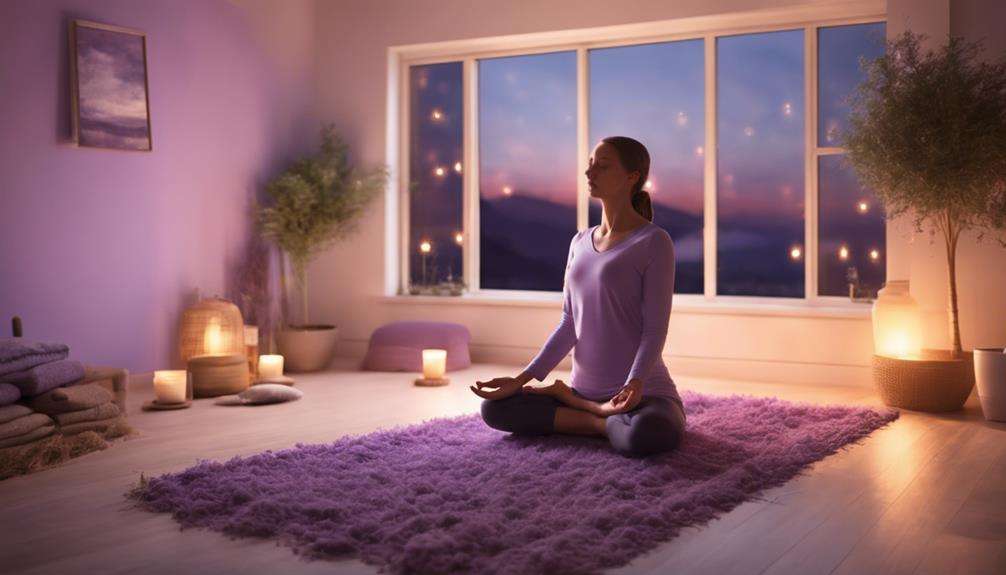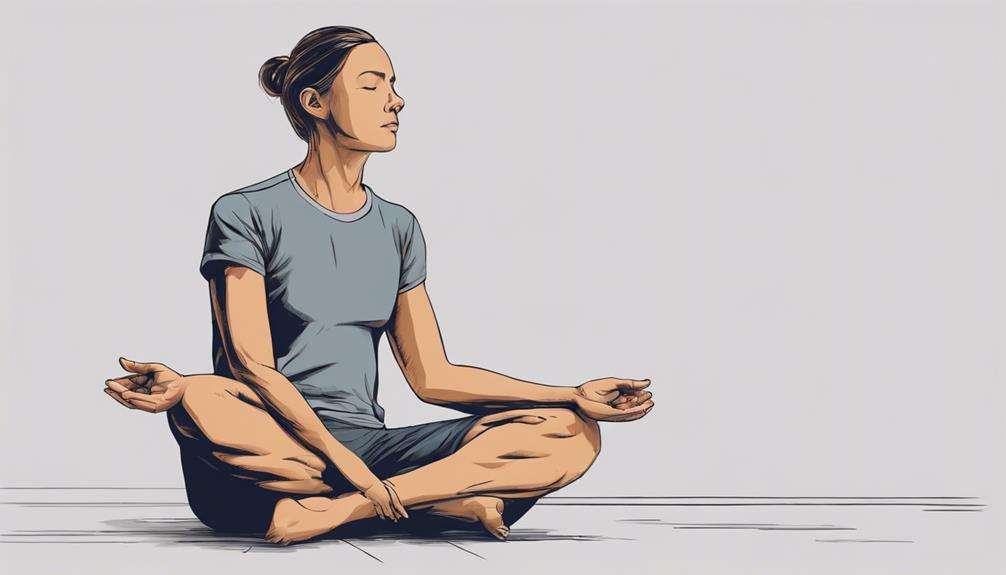When it comes to achieving deep relaxation through Yoga Nidra, it's like setting off on a journey within yourself, revealing layers of tension to expose a tranquil core waiting to be embraced.
But how can you truly access this profound state of relaxation? By mastering the art of creating a serene environment, honing your breathwork skills, and nurturing a heightened sense of awareness.
These three best practices hold the key to opening a world of inner calm and rejuvenation that awaits you, offering a pathway to profound relaxation and mental clarity.
Key Takeaways
- Systematically relax body parts for profound relaxation.
- Enhance mindfulness through visualization exercises.
- Deepen awareness with conscious breathing techniques.
- Set a Sankalpa (intention) for focused relaxation.
Benefits of Yoga Nidra for Relaxation
Discover how practicing Yoga Nidra can effortlessly guide you into a profound state of relaxation and rejuvenation. This relaxation technique not only helps in reducing stress and anxiety but also plays an essential role in improving sleep quality. By activating the parasympathetic nervous system, Yoga Nidra allows your body to enter a deep state of rest, calming your mind and releasing tension from your muscles. As a result, you experience a sense of peace and tranquility that positively impacts your overall well-being.
Through regular practice of Yoga Nidra, you can witness significant benefits such as enhanced mental clarity, reduced levels of cortisol (the stress hormone), and an overall improvement in your ability to handle challenging situations with a sense of calmness. The meditative aspect of Yoga Nidra goes beyond mere relaxation, fostering spiritual growth and self-discovery. Scientific research supports these findings, showing that Yoga Nidra can be a powerful tool for achieving deep relaxation and mental rejuvenation.
Techniques for Enhanced Relaxation
Enhance your relaxation experience with Yoga Nidra techniques that systematically relax body parts, promote mindfulness through visualization exercises, and deepen awareness with conscious breathing.
Yoga Nidra involves a guided practice that allows you to release tension from different areas of your body progressively, promoting deep relaxation.
Visualization exercises within Yoga Nidra help in reducing stress by engaging your mind in positive imagery, further enhancing the relaxation experience.
Conscious breathing techniques incorporated during Yoga Nidra not only facilitate relaxation but also promote mindfulness, allowing you to stay present in the moment.
The rotation of consciousness technique in Yoga Nidra involves bringing your awareness to specific body parts, aiding in deep relaxation and heightened awareness.
Setting a Sankalpa, or intention, in Yoga Nidra can align your practice with personal goals, aspirations, and desires, contributing to an overall sense of enhanced relaxation and well-being.
Incorporating Yoga Nidra Into Daily Routine

Consider integrating Yoga Nidra into your daily routine to experience profound relaxation and well-being benefits. Incorporating Yoga Nidra regularly throughout your day can lead to a deep state of relaxation, reducing stress and anxiety while improving your overall quality of life. Here are some tips for incorporating Yoga Nidra into your daily routine:
- Start your day with a short Yoga Nidra practice to set a positive tone for the day ahead.
- Take short breaks during the day to practice guided Yoga Nidra sessions to reset and rejuvenate your mind and body.
- Wind down before bed with a longer Yoga Nidra practice to promote restful sleep and relaxation.
Consider attending workshops and retreats to deepen your experience with Yoga Nidra and reap its benefits for stress reduction and emotional healing.
Embrace the benefits of practicing Yoga Nidra including increased inner peace, personal growth, and enhanced self-awareness by incorporating it into your daily routine.
Frequently Asked Questions
How Do I Get the Most Out of Yoga Nidra?
To get the most out of Yoga Nidra, focus on deep breathing, follow guided meditation for a body scan, use visualization techniques, and practice mindfulness. Embrace progressive relaxation, incorporate yoga postures, reflect on yoga philosophy, and find stress relief.
What Are the 5 Stages of Yoga Nidra?
To reach deep relaxation with Yoga Nidra, you'll journey through 5 stages: relaxation, intention setting, consciousness rotation, breath awareness, and visualization. Each step leads to mental clarity, stress relief, inner peace, and self-awareness.
What Is Yoga Nidra Relaxation Technique?
Incorporate these keywords when writing about the Current Question: Benefits, Techniques, Mindfulness, Meditation, Stress, Relief, Relaxation, Practice, Sleep, Therapy, Body, Awareness, Guided, Imagery, Healing, Process, Deep, Rest, Inner, Peace.
Yoga Nidra is a profound relaxation technique that combines mindfulness and guided imagery to bring deep rest and inner peace. Its healing process offers stress relief, improved sleep, and enhanced body awareness through a practice of deep rest.
What Is the Correct Sequence for Yoga Nidra?
To experience the full benefits of Yoga Nidra, start by following the correct sequence: relax in Savasana, focus on effective breathing, engage in body scanning, use visualization techniques, and let guided meditation lead you to deep relaxation.
Conclusion
Incorporate these 3 best practices for deep relaxation with Yoga Nidra into your daily routine to experience profound relaxation and mental awareness.
Remember, 'Relaxation is the key to a healthy mind and body.'
By finding a quiet space, following verbal cues, and staying alert, you can reduce stress and anxiety, improve sleep quality, and enhance overall well-being.
Make time for yourself and prioritize your relaxation for a happier and more balanced life.






